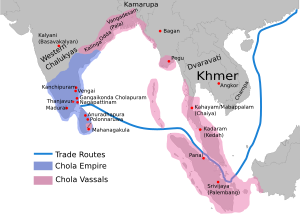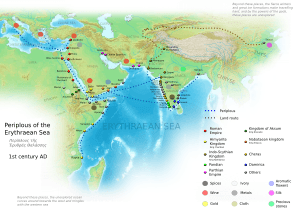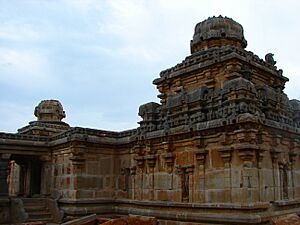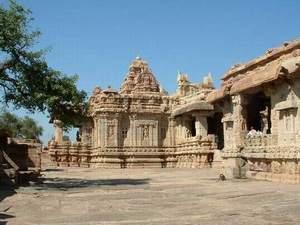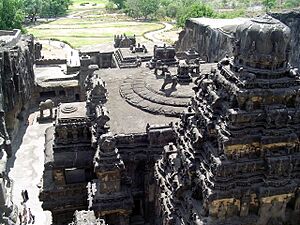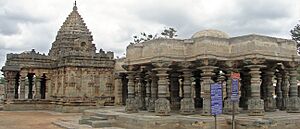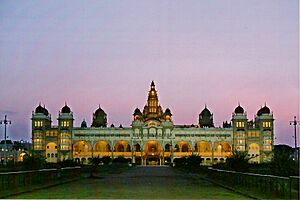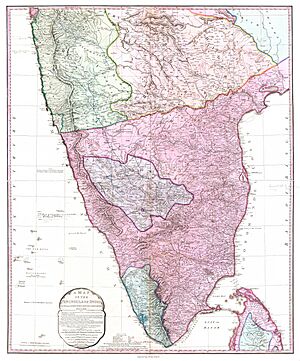History of South India facts for kids
The history of southern India is a long and exciting story that spans over 4,000 years! During this time, many powerful kingdoms and empires rose and fell.
The known history of southern India starts with the Iron Age (around 1200 BCE to 200 BCE) and the Sangam period (around 600 BCE to 300 CE). Then came the Medieval period, lasting until the 15th century CE. Famous dynasties like the Cheras, Cholas, Pandyas, Chalukya, Pallavas, and Vijayanagara Empire were very strong at different times.

The Vijayanagara Empire grew powerful to protect southern India from invaders from the north. When European countries arrived in the 16th and 18th centuries CE, kingdoms like Tipu Sultan's Kingdom of Mysore tried to fight them off. But eventually, many parts of southern India were taken over by the British.
The British created the Madras Presidency to manage southern India. After India became independent in 1947, southern India was divided into states based on language: Andhra Pradesh, Tamil Nadu, Karnataka, Telangana, and Kerala.
Contents
Ancient Times: Early Kingdoms
The earliest records of southern India are from the Iron Age, starting around 1200 BCE. Important sites from this time include Hallur in Karnataka and Adichanallur in Tamil Nadu. People from this period built large stone monuments called megaliths.
The Three Tamil Kingdoms
Around 300 BCE, three major Tamil kingdoms ruled in the south: the Cholas, Cheras, and Pandyas. Even the great emperor Ashoka knew about them!
Pandyan Rulers
The Pandyas were one of the oldest Tamil kingdoms. They first ruled from Korkai, a port city, and later from Madurai. They were mentioned in ancient Tamil writings called Sangam Literature and by Greek and Roman travelers.
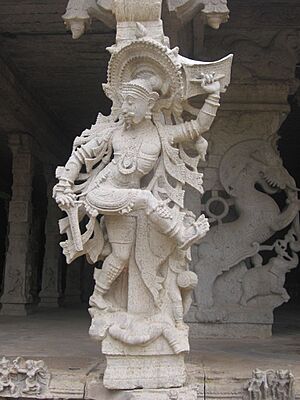
The Pandyas were known for their trade, especially in pearls. They controlled the pearl fisheries between Sri Lanka and India. They also had strong trade links with empires in Southeast Asia. The Pandyan kingdom eventually ended in the 14th century CE.
Chola Empire
The Cholas were another powerful Tamil dynasty. Karikala Chola was a famous early king who became very strong. After a period of decline, the Chola dynasty was revived in 850 CE by Vijayalaya Chola, who made Thanjavur his capital.
One of the most powerful Chola kings was Raja Raja Chola (985-1014 CE). His army conquered parts of Sri Lanka. His son, Rajendra Chola I, conquered all of Sri Lanka, invaded Bengal, and even launched a huge naval campaign that reached parts of Malaysia, Burma, and Sumatra!
The Cholas were also amazing builders. The Brihadisvara Temple in Thanjavur is a beautiful example of their architecture and is a UNESCO World Heritage Site. The Chola dynasty declined by the 13th century.
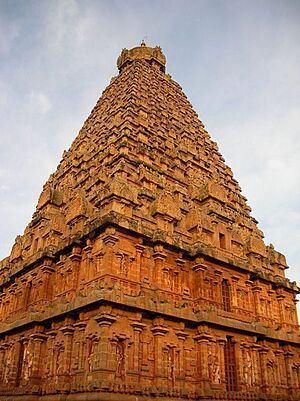
Chera Dynasty
The Chera kingdom ruled parts of what are now Kerala and Tamil Nadu. They were very active in trade, exporting spices, ivory, timber, pearls, and gems to the Middle East and Europe.
The port city of Muziris was a major trading hub for the Cheras. Roman ships would arrive there, bringing gold in exchange for spices like pepper. This trade led to small communities of Jews, Muslims, and Christians settling in Kerala's port towns. The Chera kingdom eventually declined around the 12th century CE.
Other Ancient Dynasties
Satavahana Empire
The Śātavāhana Empire was a powerful Indian kingdom that lasted for about 450 years, from around 300 BCE to 220 CE. They were based in present-day Andhra Pradesh and Maharashtra.
The Satavahanas were important for keeping peace and protecting India from foreign invaders like the Sakas. They were also one of the first Indian states to put their rulers' faces on coins. They helped spread ideas and culture between northern and southern India.
Pallava Dynasty
The Pallavas ruled in southern India from the 3rd to the 9th century CE. Their capital was Kanchipuram in Tamil Nadu. They are famous for their beautiful rock-cut temples, like the Shore Temple in Mahabalipuram, which is a UNESCO World Heritage Site.

A famous Pallava king, Narasimhavarman I, defeated the Chalukya emperor Pulakeshin II. The Pallavas and Pandyas were the main powers in southern India between the 6th and 9th centuries.
The Kadambas ruled the Karnataka region from 345–525 CE, with their capital at Banavasi. They were the first rulers to use Kannada as an official language. They built beautiful temples and later became allies of the Chalukyas.
Gangas of Talkad
The Western Ganga Dynasty ruled southern Karnataka from 350–550 CE. They were known for their contributions to Kannada literature and for building the famous Jain monuments at Shravanabelagola.
Medieval Times: New Empires and Conflicts
Chalukya Empire
The Chalukyas were a major power in southern and central India from the 6th to the 12th centuries. They had three main branches: the Badami Chalukyas, Eastern Chalukyas, and Western Chalukyas.
Pulakeshin II was a very famous Chalukya king (610-642 CE). He even defeated the powerful northern emperor Harshavardhana! The Chalukyas built many grand temples in places like Pattadakal, Aihole, and Badami, known for their unique architectural style.
Rashtrakuta Empire
The Rashtrakuta Empire ruled from 735 to 982 CE. Their most famous ruler was Amoghavarsha I, who was known for his wisdom and for encouraging Kannada language literature.
The Rashtrakutas also built some incredible rock-cut temples, including the famous Kailasa temple at Ellora Caves.
Second Cheras of Mahodayapuram
After a period of mystery, the Kulasekhara dynasty rose in Kerala. They ruled over most of modern Kerala and parts of Tamil Nadu. This period saw a flourishing of art, literature, and trade. A distinct Keralite identity, different from the Tamils, also began to form.
Arab merchants visited Kerala frequently, and there were significant Muslim communities in coastal towns. However, wars between the Cheras and Cholas in the 11th century led to a decline in foreign trade. The Kulasekhara dynasty eventually fell in 1102.
Western Chalukya Empire
The Western Chalukya Empire, descendants of the Badami Chalukyas, ruled from 973–1195 CE. Their capital was Basavakalyan in Karnataka. They were known for promoting the "Gadag" style of architecture and for a golden age of Kannada literature.
Hoysala Dynasty
The Hoysalas ruled Karnataka for over three centuries (around 1000 to 1342 CE). They started as subordinates of the Chalukyas but grew into a powerful empire.
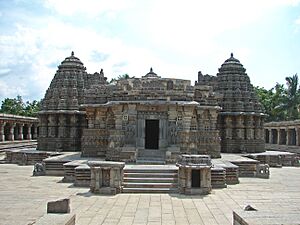
The Hoysalas built some of the most magnificent temples in South India, known for their detailed carvings and unique style. Famous temples can be found in Belur, Halebidu, and Somanathapura. They also supported both Kannada and Sanskrit literature.
The Kakatiyas
The Kakatiya dynasty became powerful in the 11th century, ruling over much of present-day Andhra Pradesh and Telangana. Their greatest ruler was Ganapatideva, who united the Telugu-speaking regions for the first time.
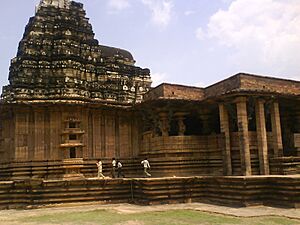
His daughter, Rudrama Devi, became a famous warrior-queen. The Kakatiyas were known for their excellent administration, military skills, and for building many irrigation tanks and artificial lakes, which helped their region become wealthy. They also encouraged trade and culture. Their capital was Warangal.
The Kakatiyas were eventually conquered by the Delhi Sultanate in 1323 CE.
Kolathunadu Kingdom
The ancient kingdom of Ezhimala in northern Kerala was later succeeded by the Mushika dynasty, which became the kingdom of Kolathunadu. At its peak, Kolathunadu stretched from Mangalore in the north to Kozhikode in the south.
This region was home to some of the oldest mosques in India, built around the 7th century CE. The Kolathunadu kingdom later split into smaller principalities.
Reddy Dynasty
After the Kakatiya empire fell, the Reddy Dynasty was established by Prolaya Vema Reddy. They ruled coastal and central Andhra from 1325 to 1448 CE. The Reddys were known for building strong forts, like those at Kondapalli and Kondaveedu. Their kingdom eventually came under the control of the Vijayanagara Empire.
Late Medieval Times: Rise of Vijayanagara
Vijayanagara Empire
The Vijayanagara Empire rose in the 14th century, becoming a major power in southern India. It was founded by Harihara I and Bukka Raya I, who were inspired by a saint named Vidyaranya to fight against Muslim invasions from the north.
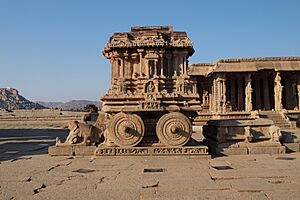
The Hoysala Empire joined with Vijayanagara, making it even stronger. The empire's capital was Vijayanagara (modern-day Hampi), a grand city.
The empire reached its peak under Krishna Deva Raya. His armies were very successful, and he expanded the empire greatly. Many important monuments were built during his reign.
However, in 1565, the Vijayanagara army was defeated at the Battle of Talikota by an alliance of Deccan sultanates. The capital, Hampi, was destroyed and never rebuilt. The empire slowly declined, and its powerful governors, called Nayaks, declared independence.
Kingdom of Kozhikode (Zamorins)
The Zamorins of Kozhikode became very powerful after the Chera kingdom declined. They allied with Arab and Chinese merchants and controlled the sea trade on the Malabar Coast for centuries.
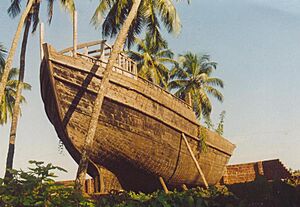
By the 15th century, the Zamorin's kingdom was the most powerful in Kerala. Travelers like Ibn Battuta and Marco Polo described Kozhikode as a major trading center where merchants from all over the world gathered.
Kingdom of Venad
Venad was a kingdom in the southwest tip of Kerala. It became important after the Chera kingdom declined. Its capital was Kollam.
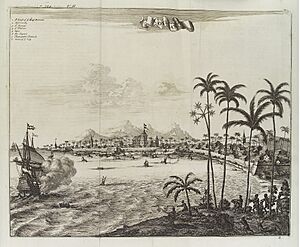
The Travancore kingdom, which became very powerful during the colonial period, grew out of Venad.
European Arrival: Portuguese and Dutch
In 1498, Vasco Da Gama arrived in Kozhikode, marking the beginning of European involvement in India. The Portuguese wanted to control the spice trade.

They allied with the Rajah of Kochi against the Zamorin of Kozhikode. The Portuguese built forts and tried to control trade, but they faced strong resistance from the Zamorin's naval forces, led by the Kunjali Marakkars.
Later, the Dutch East India Company helped the Zamorin defeat the Portuguese. However, the Dutch were also weakened by battles with Marthanda Varma of Travancore and eventually lost their power in Kerala.
Nayak Kingdoms
After the Vijayanagara Empire fell, its military governors, called Nayaks, became independent rulers. The most important Nayak kingdoms were in Madurai, Tanjore, Keladi, and Chitradurga, as well as the Kingdom of Mysore.

These Nayaks built and expanded many temples, adding large halls and tall gateway towers. Thirumalai Nayak of Madurai was famous for building the Meenakshi Temple Gopurams and his palace. These kingdoms eventually declined due to internal conflicts and invasions.
Maratha Empire
The Maratha Empire was a powerful Indian empire that grew in western India from 1674 to 1818. They were known for their strong warrior group, the Marathas, who rebelled against the Bijapur Sultanate under the leadership of Shivaji.
The Marathas expanded their empire greatly, even reaching parts of southern India like Tanjore. Their rise had a big impact on the political situation in the south.
Kingdom of Mysore
The Kingdom of Mysore was founded in 1399. It started as a small state under the Vijayanagara Empire but grew powerful in the 17th century.
During a brief period of Muslim rule, the kingdom became a Sultanate. It fought many wars with the Marathas, the Nizam of Hyderabad, and the British. The four Anglo-Mysore Wars were very important.
After Tipu Sultan's death in 1799, much of Mysore was taken by the British. The Wodeyar family was restored to power as a princely state under British rule. Mysore remained a developed and cultural center until India's independence in 1947.
Modern History: British Rule and Independence
Colonial Period
In the mid-18th century, the British and French East India Companies fought for control of southern India. They made alliances with local rulers, leading to many conflicts. The Anglo-Mysore Wars and Anglo-Maratha Wars were key events.
Eventually, the British, allied with Hyderabad, won control. Mysore became a princely state, and much of the Maratha Empire was taken by the British.
British South India
Under British rule, southern India was divided into the Madras Presidency (ruled directly by the British) and several princely states like Hyderabad, Mysore, Travancore, and Cochin. These princely states had some internal freedom but were supervised by British officials.
The British introduced crops like coffee and tea to the region.
After Independence
When India gained independence on August 15, 1947, the princely states joined the new country. Southern India was reorganized into new states.
In 1953, the first state based on language, Andhra State, was created for Telugu-speaking people. In 1956, India's states were reorganized again along linguistic lines.
- Andhra State became Andhra Pradesh and later Telangana.
- Mysore State was enlarged and later renamed Karnataka.
- The Malayalam-speaking state of Kerala was created.
- Madras State, with its Tamil-speaking majority, was renamed Tamil Nadu in 1968.
Portuguese India (including Goa) was taken by India in 1961. The French enclaves became the union territory of Puducherry.
See also
- South India
- History of India
- Nayaka dynasties
- List of Tamil monarchs
- Hinduism in South India
- History of Maurya


